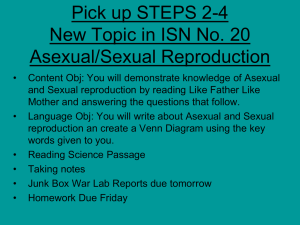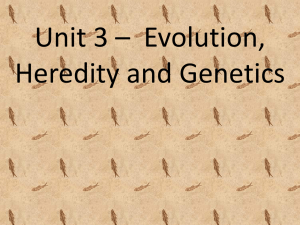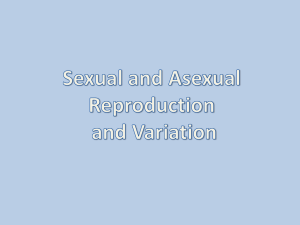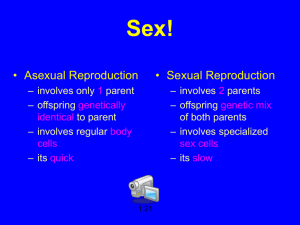Characteristic
advertisement
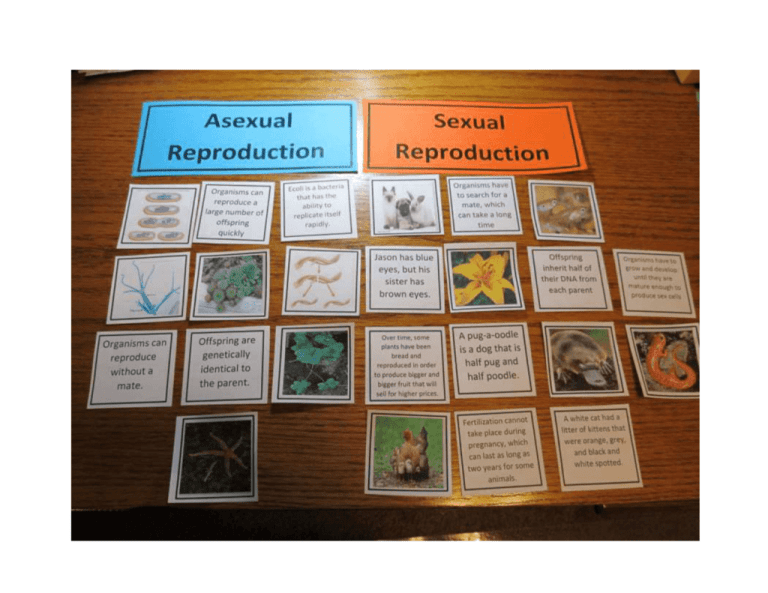
Sexual Reproduction Asexual Reproduction Uniform Offspring Diverse Offspring Example: A pug-a-doodle is a dog that is half pug and half poodle. Characteristic: Offspring inherit half of their DNA from each parent. Example: Jason has blue eyes, bus his sister has brown eyes. Characteristic: Organisms have to search for a mate, which can take a long time. Example: Ecoli is a type of bacteria that has the ability to replicate itself rapidly. Characteristic: Organisms can reproduce a large number of offspring quickly. Characteristic: Organisms have to grow and develop until they are mature enough to produce sex cells. Characteristic: Fertilization cannot take place during pregnancy, which can last as long as two years for some animals. Characteristic: Organisms can reproduce without a mate. Characteristic: Offspring are genetically identical to the one parent. Example: Over time, some plants have been bread and reproduced in order to produce bigger and bigger fruit that will sell for higher prices. Example: A white cat had a litter of kittens that were orange, grey, and black and white spotted. Name: ________________________________________________________________________Date: __________ Sexual vs. Asexual Reproduction Instructions: A. Classify and Organize the cards into two categories: sexual vs. asexual reproduction. Answer the following questions based on your classifications. 1. Compare sexual vs. asexual offspring: __________________________________________________ __________________________________________________________________________________ 2. List 1 card that you classified as sexual reproduction. _______________________________________ Explain why: _______________________________________________________________________ 3. List 1 card that you classified as asexual reproduction.______________________________________ Explain why: _______________________________________________________________________ 4. What are the advantages of sexual reproduction? _________________________________________ __________________________________________________________________________________ 5. What are the disadvantages of asexual reproduction? ______________________________________ B. Flip over the title cards. Mix up the picture & sentence cards. Organize your cards again based on diverse vs. uniform offspring. Answer the following questions. 1. Compare diverse vs. uniform offspring: _________________________________________________ List 1 card that you classified as uniform offspring. ________________________________________ Explain why: _______________________________________________________________________ 2. List 1 card that you classified as diverse offspring.__________________________________________ Explain why: ______________________________________________________________________ 3. What are the advantages of diverse offspring? ___________________________________________ _________________________________________________________________________________ 4. What are the disadvantages of uniform offspring? ________________________________________ Instructions: Read each situation below and determine if reproduction is accomplished sexually or asexually. Determine if the offspring will be uniform or diverse. 1 2 3 Platypuses are the only egg laying, duck billed, beaver-tailed, otter-footed mammal. For defense, platypus have a sharp talon called an ankle spur behind their back webbed feet. Male platypus ankle spurs actually contains venom to help them when they are in danger. The platypus reproduces by laying eggs. After hatched, the young platypus is blind and hairless until they mature. A labradoodle is a type of dog that is crossed between a labrador retriever and a poodle. The labradoodle puppy takes on the traits of both of its parents. Female dogs have a pregnancy period of almost 70 days. Fishermen work hard to catch and remove all the starfish that get into their favorite shell fishing beds and the “underwater farms” where they raise clams and oysters. In the past, they put the starfish into their boats, cut them up with knives, and then throw the pieces of starfish overboard. They thought this would kill the starfish. What they did not know was that each piece of starfish will grow into a whole new animal. 5 Guppies are the only fish that give live birth to their offspring and do not lay eggs. Guppies can vary in color and grow up to 2 inches at adulthood. Hydra is a freshwater animal that is mainly found in freshwater sources like ponds, lakes, and streams. Hydra is a small animal that is most likely seen with a microscope. Its offspring are identical to the parents and contain the same genetic coding as the parent as well. A new hydra is produced by budding. 6 A planarian is a non-parasitic flatworm. If a planarian was injured by a predator, it could re-grow its lost body parts. If the body parts were not eaten by the predator, the part could re-grow into a whole new planarian as well. 4 7 8 Salamanders have a lizard-like appearance, with slender bodies, short noses, and long tails. The female salamander lays its eggs on a stick or rock near water or on land. Some salamander species bury themselves with their eggs underground to keep them safe. There are several different species of salamdars with different colorful patterns. A plant called a Lily cannot self-fertilize. For lilies to become fertilized, pollen must be moved from the anther (male part) of one lily plant to the stigma (female part) of another plant. In most cases, birds and bees help transfer the pollen in a process called pollination. There are several different lily species of different colors and patterns. Asexual or Sexual? Uniform or Diverse Offspring? 9 10 A “hen and chicks” plant grows close to the ground with their leaves formed around each other. This plant grows best in rocky soil. The plant received its name because the hen is the main plant and the chicks are its identical offspring. If a “chick” was to become detached from the parent plant, it would form its own colony of “hen and chicks”. Mold is the discoloration or fuzzy appearance found on food when left out for a certain amount of time. Mold can reproduce rapidly and spread to the whole loaf. Mold produces spores that reproduce into more mold spores and are identical to the parent. Mold reproduces very rapidly in dark, moist environments.




